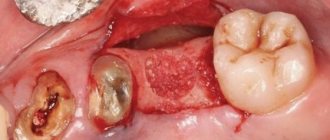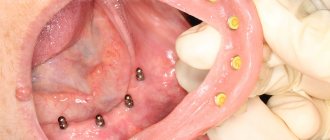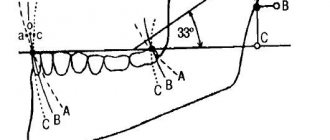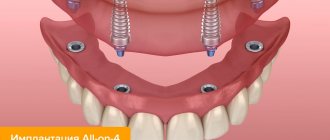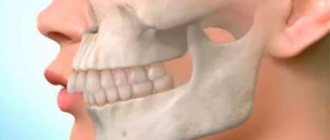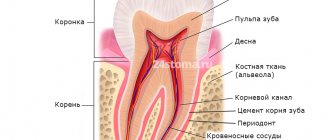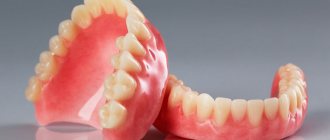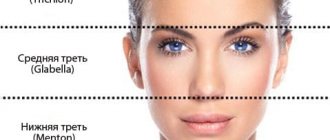A small chin (medically called inferior micrognathia, or microgenia) is an incredibly common problem.
However, most people who can be confidently diagnosed with this have not only not heard such words, but also do not suspect that there is anything wrong with them. They are healthy, everything is in place. But no matter how hard they try to achieve an ideal appearance, it doesn’t work!
Neither losing weight, nor taking care of your face, nor changing your hairstyle helps. It's not clear what's going on! As a result, people either come to terms with the fact that everyone is imperfect, or they suffer all their lives because the ideal is unattainable for them personally.
Diagnosis: complete absence of teeth
Partial edentia means that the patient is missing several teeth. Multiple edentia is a condition in which more than 10 teeth are missing. If the patient has lost the entire dentition - on one or both jaws, then the doctor diagnoses “complete edentia”. As a rule, people in adulthood face this problem, but in exceptional cases, this diagnosis can occur in young people and even children.
There are two types of edentia.
- With primary adentia,
a person is born with dead/undeveloped tooth rudiments. Even partial primary adentia occurs in only 1% of cases of all dental anomalies, and complete primary adentia is an extremely rare diagnosis. The congenital absence of tooth buds is caused by various hereditary factors or diseases that provoke disturbances in the development of the dental plate. Thus, the cause of congenital adentia can be ichthyosis, hypothyroidism, pituitary dwarfism, and infectious diseases. - Secondary complete adentia
is most common in adulthood, affecting about 20% of people over 65 years of age. This form is considered acquired; it is provoked by:
- metabolic disorders;
- age-related changes;
- injuries to teeth and jaw;
- gum disease;
- caries and its complications.
Periodontitis, periodontal disease, periostitis, pulpitis, periodontitis without high-quality and timely treatment can lead to complete or partial adentia even at a young age.
What is secondary edentia
Why, with partial edentia, teeth cannot fully perform the chewing function?
What does partial adentia lead to?
In dental practice, a situation often occurs when a patient is missing several teeth and one could say that this is partial adentia, BUT the remaining teeth are in such a deplorable condition that they cannot perform their natural functions, and in this case it would also be complete edentia, i.e. lack of teeth for chewing food.
On the picture
- partial edentia
Orthopedic treatment of complete edentia
In case of complete edentia, the doctor can offer two main correction options: implantation followed by prosthetics or wearing a complete removable denture.
Removable dentures were very popular before the advent of implant prosthetics, accessible to a wide range of people. Now removable dentures are used, but are not considered the optimal solution to the problem. In modern dentistry, several types of removable dentures are used:
✔
acrylic;
✔
nylon.
Acrylic removable dentures consist of a solid base and attached artificial teeth. The lack of flexibility gives these prostheses several special qualities, which are both the main advantage and the main disadvantage. On the one hand, a solid base contributes to an even, healthy load on the entire jaw when chewing food. However, this same property makes the prosthesis more fragile and less comfortable to wear compared to more elastic structures. Acrylic dentures have a porous structure on which bacteria and plaque accumulate; the monomer in their composition can cause an allergic reaction. When choosing this design, we recommend paying attention to Acry Free prostheses, made from the latest type of plastic without toxic substances. They are more modern, durable and flexible, but their cost is higher than other acrylic prostheses.
Nylon prostheses are more flexible and aesthetic. They are made from hypoallergenic materials. However, they have insufficient rigidity, which affects the quality of chewing food and contributes to rapid atrophy of bone tissue. Because of this, nylon dentures made of polyurethane and other materials are not recommended for use in completely toothless jaws.
Micrognathia and macrognathia: treatment
Since a child is often born with this anomaly, doctors recommend using special pacifiers and nipples in the first year of life.
For the treatment of micrognathia and macrognathia in adults, different orthodontic structures are used:
- Katz guide crown;
- chin sling;
- corrective mouthguards;
- special plate with a pull-out.
If treatment with this method does not produce results, surgical intervention is possible: the bone is cut and reconnected, the jaw is fixed with a splint so that the bones grow together correctly. This operation can be performed by either a surgeon or an orthodontist. Some dental clinics are engaged in correcting underdevelopment of the lower jaw and other pathologies described above.
The iOrtho clinic network provides high-quality services for correcting malocclusion with Invisalign aligners, sign up for a consultation now!
Completely edentulous upper jaw
In case of partial absence of teeth, the prosthesis rests on the remaining units. If it is full, there is no such possibility of fastening, which may cause difficulties with the installation of the prosthesis. Therefore, dentures for the upper and lower jaws have significant design differences. Dentures for the upper jaw include a volumetric base that imitates the anatomy of the palate, which ensures a tight fit. To improve fixation, special gels are used. Dentures for the lower jaw do not require additional fastening elements, since they repeat its alveolar part.
What is microgenia (micrognathia) of the lower jaw
Microgenia of the lower jaw is nothing more than a small underdeveloped chin. A defect in appearance caused by a lack of bone in the chin area.
A young girl contacted Platiennetal with complaints about a small chin and asymmetry of the chin area.
A chin augmentation was performed using a Porex implant, Bisha's fat bags in the cheek area were partially removed. It was possible to visually narrow and “stretch” the oval of the face, making it harmonious.
Performed by: plastic surgeon Andrey Iskornev
Photo from the patient’s personal archive. Surgeon: Iskornev A.A.
Performed: upper blepharoplasty, ️installation of a chin implant, medial and lateral platysmaplasty with neck lift through an incision in the earlobe. Performed by a surgeon - Maxim Vasiliev .
A small or sloping chin spoils any face. And if a small chin in men can still be hidden under a thick beard (for those who find the strength to wear this “decoration”, which makes the owner look ten years older), then a small chin in women cannot be disguised.
Looking at a human face, we often see only the whole and do not notice the details.
A short chin in itself is not noticeable and is not perceived as a flaw. But with its size it violates the proportions. From the side, a fuzzy oval of the face, early wrinkles, folds on the neck and a premature double chin are visible. And only a specialist - a maxillofacial surgeon or an orthodontist - will understand that the reason is the insufficient size of the chin.
Which prosthetics are better for complete edentia?
Classic removable dentures are affordable, but they are not able to provide everything necessary for a high quality of life:
- functionality;
- comfort to wear;
- quality of chewing food;
- healthy load on the jaw;
- restoration of the natural shape of the face.
This is a half-measure that does not allow us to fully restore a decent quality of life. This is why dental implantation is the best solution for complete edentia. Computer modeling methods allow you to understand what your smile and overall face will look like even before implants and prostheses are installed. At the same time, computer programs help to accurately determine the location of future implants to restore the natural shape of the face, eliminate deep wrinkles, hollow lips and cheeks caused by missing teeth.
In case of complete absence of teeth, two concepts of implantological treatment are provided: classical and mini-implantation.
With mini-implantation, which is considered a temporary solution, the prosthesis is installed immediately after implantation. With mini-implantation, only removable prosthetics are available, and the design is inferior to classical prosthetics in terms of reliability and durability.
In the classic version, the patient undergoes the procedure of engrafting several implants - artificial roots made of titanium, which will serve as support for the future prosthesis. To securely attach the prosthesis, a minimum of 4 implants are required in the upper jaw and 3 in the lower jaw. But in a number of clinical cases, to achieve better stability, it is recommended to use a larger number of implants. After 6 months, when the implants have finally taken root, a permanent prosthesis is installed on them.
Causes of edentia
The first cause of adentia is periodontitis.
The second cause of edentia is caries.
The third reason for tooth loss is pulpitis
The fourth cause of adentia is periodontitis.
The fifth possible cause of adentia is hypoplasia
The most common thing is the lack of proper oral hygiene and care.
There are three diseases that provoke tooth loss - periodontitis (soft tissue diseases), caries and its complications (pulpitis and periodontitis) and hypoplasia (underdevelopment of tooth tissue, most often enamel).
There are other reasons for tooth loss - due to a blow or some complex disease - but such cases are exceptions to general practice, so we will not dwell on them in detail.
The main reason leading to tooth loss is, after all, a lack of proper attention to one’s health and letting the first signs of illness take their course.
There is no consensus or single way to prevent caries or periodontitis; the occurrence of these diseases can be influenced by various factors - genetic predisposition, poor nutrition, poor hygiene and even the area of residence. But timely diagnosis and proper treatment always save the patient from many further health problems.
Features of treatment
Complete dentures on implants can be removable or conditionally removable. Removable ones are used for mini-implantation. Conditionally removable dentures are removed only in the dentist's office.
In classical prosthetics on implants, different fastening methods are used.
- Push-button fixation
is carried out using abutments - equatorial or spherical. When the prosthesis is fixed, the lock is activated. With some force, the prosthesis can be removed for inspection and hygiene procedures. - Another method is beam fixation.
First, a beam is made to connect the already installed implants. The prosthesis itself is attached to it. Prosthetics using this method are more reliable, but more expensive. From a technical point of view, it is more difficult to carry out.
Bite with complete absence of teeth
With complete edentia, the jaw looks unaesthetic, and the shape of the patient’s face changes significantly. In this situation, specialists need to recreate the correct bite so that the prosthesis does not protrude or sink.
In order for the prosthesis to fit correctly, correcting aesthetic and functional problems caused by edentia, it is necessary:
- calculate the occlusal height of the upper jaw;
- form a prosthetic plane;
- determine the height of the lower facial region;
- determine the central relationship of the jaws and fix it with notches.
To determine central occlusion, the doctor holds the corners of the patient's mouth. After the patient swallows saliva, the jaws close correctly.
Consequences of adentia or tooth loss
How are complete dentition and facial appearance related?
The loss of even one tooth already affects the patient’s appearance, let alone when teeth are completely missing. A person ages sharply, and the effect of the so-called “senile face” appears, when the distance from the tip of the nose to the top of the chin decreases greatly. This occurs due to a decrease in the height of the lower third of the face. Since there are no teeth, the support of the lower jaw by the teeth is lost, and the jaw moves backward in the joint area, and forward and upward in the chin area.
This displacement of the jaw leads to a decrease in the tone of the facial muscles, as a result of which the cheeks and chin sag, the corners of the lips go down, even the lips become smaller, as if falling inward. The face becomes more mature.
Dental restoration has a rejuvenating effect, as it allows you to return the lower jaw to its normal position, which provides the necessary support to the soft tissues and restores the smile. After treatment, patients regain confidence and quality of life improves.
How to improve your facial contour without going to a cosmetologist
The “senile face” effect can also occur with partial loss of teeth, especially the chewing group. Sometimes a woman goes to a cosmetologist to tighten her facial contour, and he refers her to a dentist to restore missing teeth. Good, responsible cosmetologists understand that any rejuvenation procedures will not give the expected effect if there are no teeth in place.
